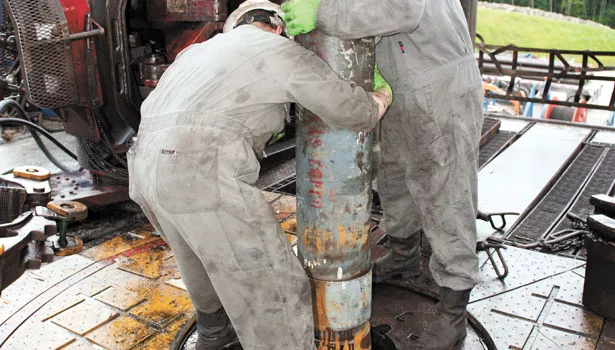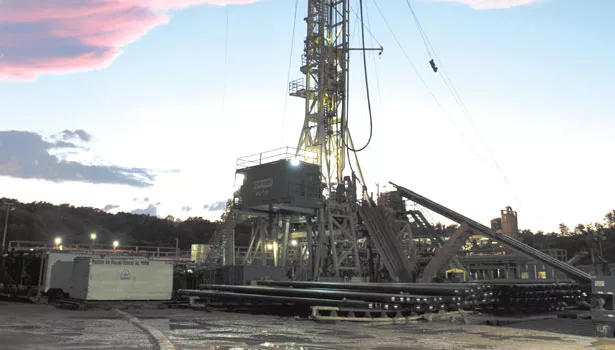The Benefits of Pneumatic Drilling

Using an Atlas Copco Secoroc QL 120 hammer to drill 12-inch-diameter holes, the rate of penetration exceeded 400 feet an hour. Source: Atlas Copco photos

Tom Weller prefers pneumatic drilling for carrier-mounted top drive rigs doing surface work. Source: Atlas Copco photos
Pneumatic hammer drilling gives drillers an advantage in all but the most extreme soft ground conditions says Josh Marcus, senior product specialist of Atlas Copco Secoroc down-hole tools. And when weighted drilling fluid is not required to control the formations, hammer drilling should be the favored technique.
“A conventional triple drill rig is great for drilling with the QL 120 hammer,” says Tom Weller. “Hydraulics give perfect control on the break. You can control it with fast reaction to weight on bit and maintain a constant feed rate.”
Weller is one of the industry’s leading proponents of pneumatic drilling. Not only does he prefer it for carrier-mounted top drive rigs doing surface work, he also takes advantage of its cost-reducing speed on conventional rigs.
Weller was working as a drilling superintendent for an unconventional oil and gas development company at an Ohio pad that required 10 top holes. Using an Atlas Copco Secoroc QL 120 hammer to drill 12-inch-diameter holes, the rate of penetration exceeded 400 feet an hour. Weller says, “We were flying along. In just over 16 hours, we drilled 2,550 feet.”
He mentions that the instantaneous ROP read up to 600 feet an hour at times, and they would pull back for cutting management. “To drill this fast you have to know the formation,” he says.
Pushing the hammer in an abrasive formation could cause premature failure of the bit. For that project, they were drilling through Onondaga limestone and then a big seam of Oriskany sandstone at 4,100 feet. After that, they passed through hard Clinton sedimentary rock before the Queenston shale beds to the resource layers.
The well profile and casing changes were engineered to the formation. After setting 30-inch conductor casings to 100 feet, drill crews isolated the fresh water zone with a 24-inch hole to 500 feet cased with 183⁄8-inch pipe.
From there, the well profile narrowed to a 17-inch hole to 1,500 feet cased with 133⁄8-inch pipe, continuing the next 4,700 feet to the kickoff with a 12-inch hole and 5-inch pipe.
The drilling crew vertical-drilled the hole all the way to its 6,200-foot kickoff point solely with the QL 120. Drilling with air controlled the formation’s water, using flow rates of up to 6,700 cfm with pressures up to 440 psi.
The drill string consisted of 5-inch drill pipe, nine 6-inch collars and an Atlas Copco 12-inch carbide button bit. The weight on bit was from 8,000 to 15,000 pounds and the rotation was 25 rpm.
To complete the well for production, drilling crews fluid-drilled through the oil-producing formation after the kickoff point with an 8-inch PDC bit to a total depth of 14,859 feet cased with 5-inch pipe.
The drill was penetrating so fast, it produced 20 tons of cuttings an hour more than rotary had. In fact, it took seven people to manage cuttings instead of the usual four.
The total cost of the hole was calculated to split equally—about half for the vertical and half for the lateral. In general, the longer the lateral, the more expensive the hole’s overall cost per foot.
By comparison, mud drilling would have progressed at 400 to 800 feet per day. Pneumatic hammer drilling had been averaging 2,000 feet or more per day.
The final cost analysis includes the operational cost, which is mostly fuel. For fluid drilling, the rig consumes about 1,500 gallons of fuel per day. On air, it only uses 400 gallons. Even including fuel used by eight compressors and their generators, with a combined fuel use of 3,680 gallons a day, air cut overall drilling costs in half.
Looking for a reprint of this article?
From high-res PDFs to custom plaques, order your copy today!






